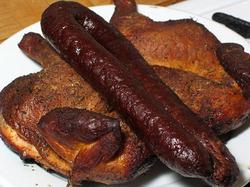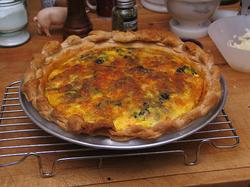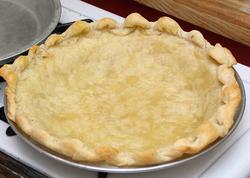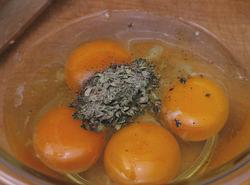

Wow, what a weekend. I started my Saturday off by heading out to the Berkeley Farmer’s Market to visit my pals. I have to say, spring has sprung and people are out. The Fatted Calf had a row of customers 40 minutes before opening and Jan at Blue Bottle Coffee was swamped when I arrived soon after opening (10am). She qued me several times to jump in and make myself useful. That didn’t happen, I was still all twitterpated from the work week and ‘jumping in’ on a Saturday wasn’t a possibility, this time.
Since the weather was fair I decided to get myself some Hungarian Kielbasa from Taylor & Kim for some smokey barbecue love action later that same day.
And that is what I did. Around 3pm I fired up the smoker and got my hickory fire all warmed & spread nicely. In went a olive oil and herb flat chicky and I saved the kielbasa for the last hour and a half.
The chicken was served with Everett & Jone’s barbecue sauce, warmed ever so gently. IT WAS JUICY NICE !!! You are well aware of how juicy a chicken can be when cooked in your oven at home? It was that juicy coming out of the smoker. What a TREAT. The Kielbasa was rich and bright and just enough heat to make you smile. Since there were only two people for dinner, my wife and I (the chillins won’t eat smoked meatses), we saved half the kielbasa for Sunday’s meal.
We had to make a few more trips to the store, but later Sunday found my wife hard at work in the kitchen with pie dough. Here is where the remaining sausage met its divine end.
Here is mama:
_Quiche with Red Chard and Kielbasa
_The following recipe was adapted from recipes for “Lard & Butter
Pastry” and “Quiche Lorraine” from Susan G. Purdy’s /*As Easy as Pie*/.
Crust:
2 cup flour
1/3 cup duck confit (sans fleshy pieces)
1/3 cup butter
3/4 tsp. salt
5-7 tbsp. ice water (just enough to hold the dough together)
Why did I use duck fat? I did it because I wanted to know if duck fat
was happy and tasty in pie crust. Below are the details of my experiment.
The first thing I noticed when trying to separate the fat from the duck
pieces in the confit was that the fat was warmed up very quickly and was
a little runny around the edges. Ick, I didn?t expect that. I didn’t
like the smell of the duck confit either — too ducky, downright fowl
(get it?). Seriously, I was a little worried that the odor of the pie
crust would overpower its contents. But, there was no way to tell
without baking it, so I forged ahead.
After I extracted the duck fat, I cut it and the butter into the flour
and salt with my ever-faithful pastry cutter. I added 5 tablespoons of
ice water and pinched the dough together. It didn?t want to hold at
first so I added another tablespoon of water and re-pinched the dough.
Still no dice or dough. So I added yet another tablespoon of water and
pinched for a third time. Finally, the dough began to come together, but
still some bits were dry. I sprinkled drops of water on the dry bits and
formed the dough into a ball, wrapped it up in plastic and chilled it
for an hour. I wanted to make sure that both fats in the dough,
especially the oozy duck fat, were good and cold before I started
rolling it out.
After an hour, I floured the butcher block and flattened the cold dough,
then rolled it out, and transferred it into the pie tin. I shaped the
edges of the crust, and used a fork to prick the bottom and sides of the
pie crust as required for a ?blind-baked? crust. Next, I placed another
pie tin on top the dough in the first pie tin. I placed the sandwiched
pie dough upside-down and supported by bowl into the refrigerator to
chill for another 30 minutes. (Chilling the dough relaxes something and
prevents dough shrinkage while baking. I don?t remember all the science
behind it ? I just do it, and it works.)
After the dough was thoroughly chilled, I put the upside-down sandwiched
pie dough on top of one of those domed steamer inserts to support the
tins and keep the fluted edges of the pie crust from being crushed.
Then, I put the whole kit and caboodle into the oven which was preheated
to 375 degrees. After 10 minutes, I removed the sandwiched pie dough and
steamer. I turned the pie tins right-side up, removed the top pie tin,
and set that aside along with the steamer. Next, I brushed the pie crust
with an egg white wash, and returned the un-sandwiched pie crust into
the oven to bake for 3 more minutes. (The egg wash moisture-proofs the
pie crust.) And voila, the pie crust was done and I set it aside to cool.
The pie crust came out rather well. It wasn’t as light and flaky as an
all butter crust, or a lard crust, but for the quiche, it worked out
marvelously. The only thing I didn’t like was the smell which resembled
“Chicken In a Bisket” crackers which I detest by the way. I guess I’m
just not used to the smell of duck fat. I’m not big on the smell of pork
fat either, but it does make one a helluva yummy pie crust.

But what is a pie crust, flaky or not, without a filling?
For Susan Purdy’s Quiche Lorraine, you’re supposed to use eggs, half ‘n
half, shallot, salt, pepper, and butter. But I wanted to do something
different, and to do something nice with the lovely bunch of organic red
chard that I purchased from Planet Organics. I also wanted to play with
the pebrella. Plus, we had some kick-ass smoked kielbasa in the fridge.
So, it here goes…
Filling:
4 eggs
1 1/2 cups half n’ half
1/2 tsp. salt
1/2 tsp. pepper
1/2 tsp. pebrella
1 shallot (minced)
1 bunch of red chard (shredded by hand into 1-2 inch pieces)
1/2 – 3/4 cup swiss cheese (grated)
1/4 – 1/3 cup of smoked kielbasa cut into 1/4″ pieces.
1 tblsp. butter

I saut

Okay, Mister! You got me on this one. Yummmmmmmy! I love chard and I love Kielbasa and the recipe, finished product and picture make me yearn for those “brisk” Eastern European winters and the aroma of this quiche wafting from the cooker!
Oooh, that looks good. Is there any kind of pie that doesn’t taste good??
Oh yeah, the ones from McDonalds 😉
Hey Lady …
Pies made with Crisco don’t taste good. Pies made with healthful, organic, non-transfat vegetable shortening don’t taste nice either. And that’s a shame because I’m a big fan of organic food stuffs. But if it don’t taste good, I ain’t eatin’ it no matter what.